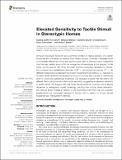Files in this item
Elevated sensitivity to tactile stimuli in stereotypic horses
Item metadata
| dc.contributor.author | Briefer Freymond, Sabrina | |
| dc.contributor.author | Bardou, Déboraht | |
| dc.contributor.author | Beuret, Sandrine | |
| dc.contributor.author | Zuberbuhler, Klaus | |
| dc.contributor.author | Bachmann, Iris | |
| dc.contributor.author | Briefer, Elodie F. | |
| dc.date.accessioned | 2019-05-31T09:31:15Z | |
| dc.date.available | 2019-05-31T09:31:15Z | |
| dc.date.issued | 2019-05-31 | |
| dc.identifier | 258935039 | |
| dc.identifier | f0acfdf3-1eab-47bd-a7e4-2f4ad0e410bc | |
| dc.identifier | 000470014500001 | |
| dc.identifier | 85068206320 | |
| dc.identifier.citation | Briefer Freymond , S , Bardou , D , Beuret , S , Zuberbuhler , K , Bachmann , I & Briefer , E F 2019 , ' Elevated sensitivity to tactile stimuli in stereotypic horses ' , Frontiers in Veterinary Science , vol. 6 , 162 . https://doi.org/10.3389/fvets.2019.00162 | en |
| dc.identifier.issn | 2297-1769 | |
| dc.identifier.other | ORCID: /0000-0001-8378-088X/work/64360740 | |
| dc.identifier.uri | https://hdl.handle.net/10023/17786 | |
| dc.description.abstract | Although stereotypic behaviours are a common problem in captive animals, why certain individuals are more prone to develop them remains elusive. In horses, individuals show considerable differences in how they perceive and react to external events, suggesting that this may partially account for the emergence of stereotypies in this species. In this study, we focussed on crib-biting, the most common stereotypy displayed by horses. We compared how established crib-biters (“CB”=19) and normal controls (“C”=18) differed in response to a standard ‘personality’ assessment test battery, i.e. reactivity to humans, tactile sensitivity, social reactivity, locomotor activity, and curiosity versus fearfulness (both in novel and suddenness situations). Our analyses showed that crib-biters only differed from control horses in their tactile sensitivity, suggesting an elevated sensitivity to tactile stimuli. We suggest that this higher tactile sensitivity could be due to altered dopamine or endogenous opioid physiology, resulting from chronic stress exposition. We discuss these findings in relation to the hypothesis that there may be a genetic predisposition for stereotypic behaviour in horses, and in relation to current animal husbandry and management practises. | |
| dc.format.extent | 4 | |
| dc.format.extent | 763650 | |
| dc.language.iso | eng | |
| dc.relation.ispartof | Frontiers in Veterinary Science | en |
| dc.subject | Personality | en |
| dc.subject | Crib-biting horses | en |
| dc.subject | Horses | en |
| dc.subject | Stereotypes | en |
| dc.subject | Coping styles | en |
| dc.subject | β endorphin | en |
| dc.subject | QP Physiology | en |
| dc.subject | RC0321 Neuroscience. Biological psychiatry. Neuropsychiatry | en |
| dc.subject | NDAS | en |
| dc.subject.lcc | QP | en |
| dc.subject.lcc | RC0321 | en |
| dc.title | Elevated sensitivity to tactile stimuli in stereotypic horses | en |
| dc.type | Journal article | en |
| dc.contributor.institution | University of St Andrews. Institute of Behavioural and Neural Sciences | en |
| dc.contributor.institution | University of St Andrews. Centre for Social Learning & Cognitive Evolution | en |
| dc.contributor.institution | University of St Andrews. School of Psychology and Neuroscience | en |
| dc.identifier.doi | 10.3389/fvets.2019.00162 | |
| dc.description.status | Peer reviewed | en |
This item appears in the following Collection(s)
Items in the St Andrews Research Repository are protected by copyright, with all rights reserved, unless otherwise indicated.

